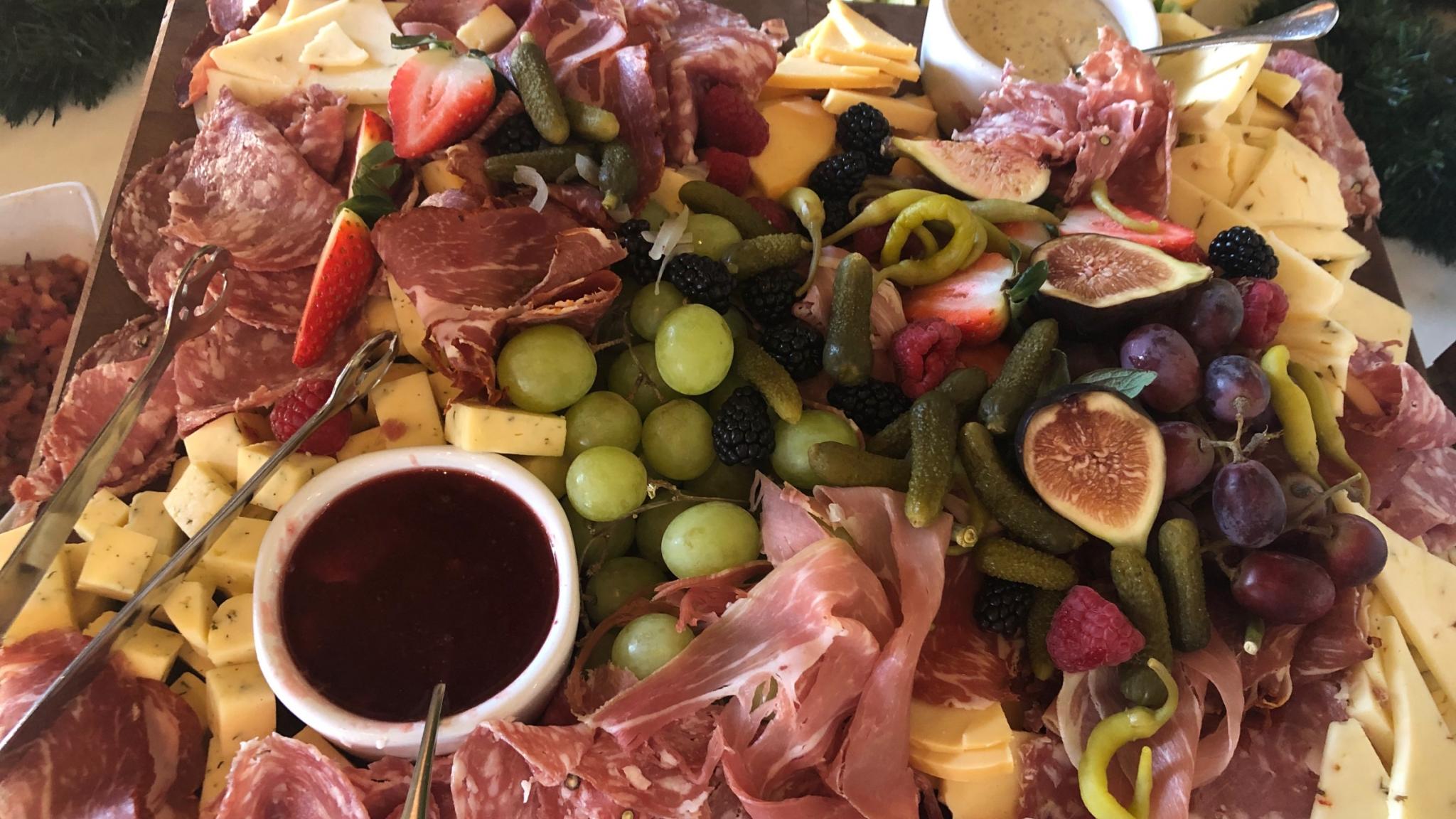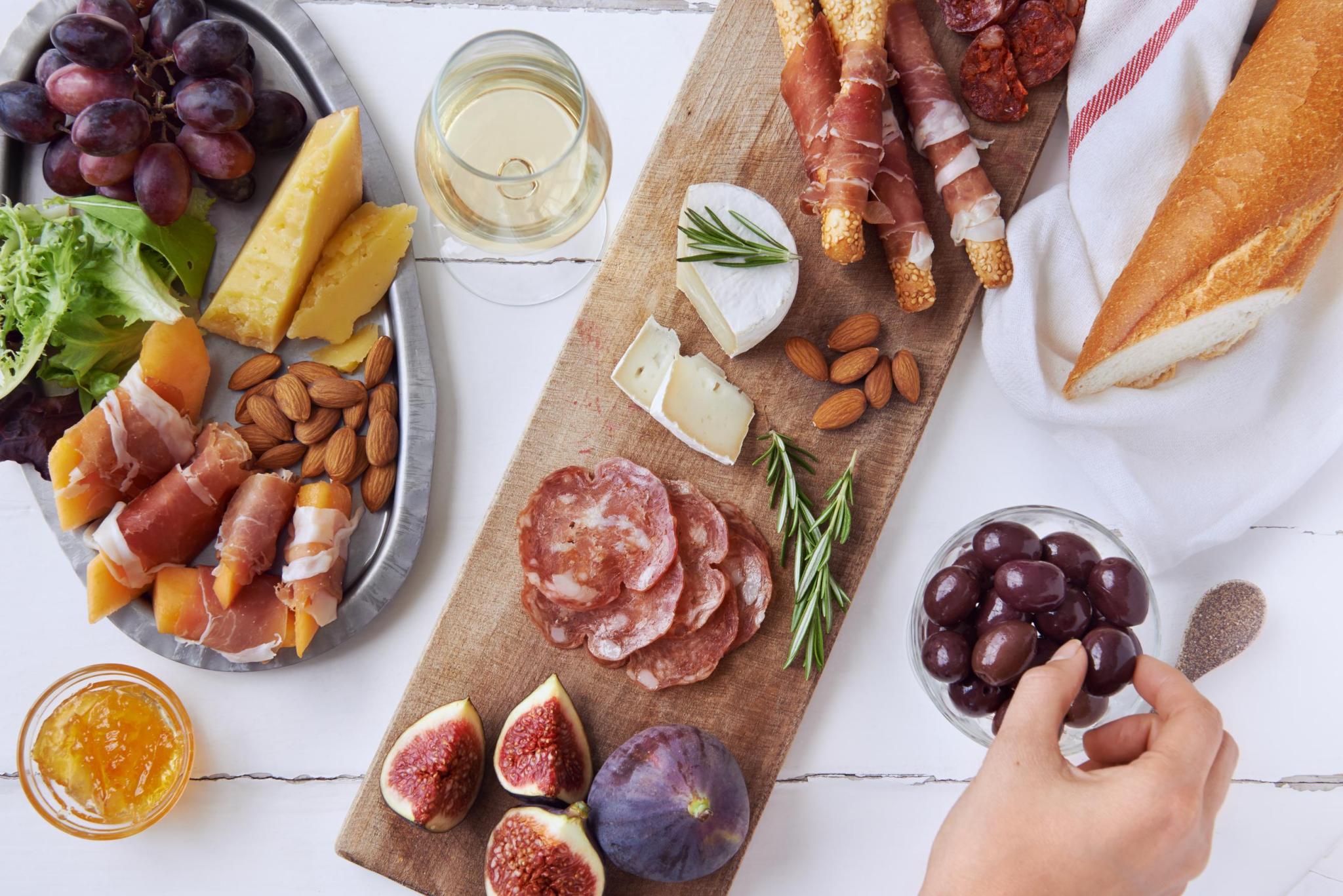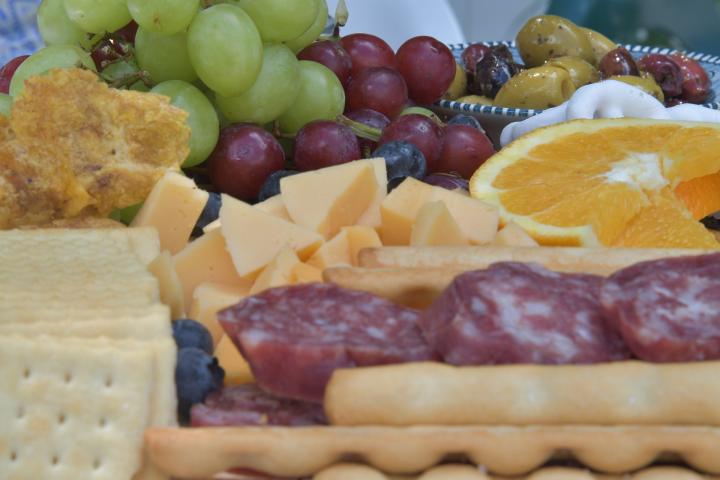Making charcuterie boards and platters is not only a great way to serve appetizers, but also a fun way to do something different for the holiday dinner table. Guess enjoy helping themselves to favorite foods, it’s far easier on the host than a traditional dinner, and it’s fun.
Due to some recent health issues, I needed to minimize exertion but still wanted to bring some variety and great ingredients to the holiday table. For some reason, this idea of bowls and boards entered my mind. It was quite festive! My guests loved the change from the long-sit down dinner with me hopping up and down from my seat.
All you need to do is cut the items so it’s easy for guests to help themselves. Keep slices to one or two bites per guest and include knives on the board.

Meat and Cheese Boards
The board itself can be as simple as a wooden cutting board or a large serving platter.
-
Charcuterie board: A charcuterie board has at least a couple types of cured meats, usually one soft and mild option (such as prosciutto) and one firm and hard option (such as salami). If you wish, roll the meats (or fold) to make it easier to eat. You can also add a couple cheeses to this board—a soft or semi-soft cheese such as a Brie and a hard cheese such as a cheddar. Keep “like” meats and cheeses grouped together. Small bowls with condiments can be set near the center. Thin slices of baguette or French bread or a variety of crackers can be placed in bowls or baskets nearby.

- Cheese board: Or, just do a cheese board without meats. Three cheeses is often by “go to” since people have different tastes. Mix the flavors—a soft cheese with a bolder option such as semi-soft Gouda. Add a classic hard cheese such a Vermont cheddar. Avoid blue cheeses which tend not to be crowd pleasers. Stack or swirl crackers, flatbreads, or crostini in small bowls or baskets on or near the board. Fill empty spaces with some garnishes such as seedless grapes or dried figs.
Ideas for Bowls and Platters
- Bowls of dip: pesto, hummus, olive spread, or any dip is always popular. Consider dips that add color or new flavors to the board. Leave room around the bowls for crunchy vegetables to dip.
- Seasonal fruit and vegetables: Add a bowl or platter with something sweet such as grapes, figs, dried or fresh berries. Colorful veggies such as mini carrots, radishes, cucumbers, bell peppers, figs, and grapes.
- Something acidic: Think pickles (cornichons), pickled green beans, pickled jalapenos.
- Platters with sliced, roasted meats and basket of sandwich breads (soft baguette or sliced buns)
- A giant bowl of mixed salad greens tossed with roasted chickpeas, black beans, and/or lentils.
- Add-ons for salads, sandwiches, and soups: fresh or roasted peppers, grape tomatoes, steamed broccoli florets, sliced cooked beets, carrot sticks, thinly sliced onions, hard-boiled eggs, edamame.
- Pastas with mix-ins: olives, grape tomatoes, steamed broccoli florets, grated mozzarella
-
Nuts: Almonds or cashews or a healthy, delicious nut mix is a good idea for those who want to avoid sweets.
-
Soups: For fall or winter, a comforting bowl of seasonal soup or a soup night with several soups is a fun idea. Add a basket of delicious bread.
- For a more festive board, spring for some might-adds: fancy olives, smoked salmon, shrimp, marinated mushrooms, and artichoke hearts

What’s in the Pantry?
If you’re a gardener or keep your freezer stocked, you may find that you’ve done much of the work!
- We already have two freezers full of many different vegetables (roasted peppers, steamed broccoli, baby green beans, pea pods) and fruits (five kinds of berries and cubed melons). In our case, it all comes from the garden.
- I have containers of well-seasoned broths in the freezer, ready to thaw and receive vegetables for soup.
- I’ve canned dozens of jars of tomatoes, tomato sauces, and salsas, along with jars of fruit jams and pickles.
- We’ve stashed a winter’s supply of home-grown onions, purple- and yellow-fleshed potatoes, winter squash, sweet potatoes, carrots, beets, and garlic in the cellar.
- Our kitchen opens onto a small solar greenhouse which has begun and will continue producing a variety of cut-and-come-again salad and cooking greens until spring.
- Our cellar shelves are already stacked with several weeks’ worth of emergency supplies along with a few fancier things in case of unexpected company: canned tuna, chicken, sardines, smoked herring, etc.
Preparing Ahead
I did a little extra work during the past few weeks that didn’t seem that onerous:
- I baked the bread and stored in the freezer: a big load of flatbreads, baguettes, pitas, and loaves.
- As I was preparing other meals, I cooked up and froze dry beans, chickpeas, lentils, and brown barley in various-sized containers. See my lentil soup recipe.
- Finally, we did a big final shopping: a pound of smoked salmon, a big bag of frozen shrimp, a variety of hard cheeses, several boxes of whole-grain crackers, a few quarts of yogurt, several bags of green pears and winter apples, and an assortment of nuts, seeds, and dried fruits (our usual snack foods).
The Pies
Oh, I’ve allowed one major deviation. Pies. I’ve baked and frozen three pies from my summer larder: a squash-maple, a blackberry, and a blueberry. See pie-making tips.
For a quick dessert, consider a blackberry cobbler or a fruit crisp.
The Leftovers
With the leftovers, enjoy bowls of oatmeal and berries for breakfast. For dinner? Mix up a container of broth, a load of diced vegetables and a container of barley or white beans, and—voila!—a hearty soup. Broccoli-cheese soup. Black-bean chili. White-bean chili. It becomes a feast when accompanied by a platter of pitas, crackers, cheeses, hummus & other dips, olives, sliced beets, carrot sticks, broccoli florets.
Yes, we’ll bypass a lot of traditional cooking this season. But we will be chatting online and on the phone, and sharing with everyone how well we’re eating.
Bon Appétit to us and to you. Wishing you all a season of groaning boards and overflowing bowls.












